T1 DAAP 1000DOH
1/245
Earn XP
Name | Mastery | Learn | Test | Matching | Spaced |
|---|
No study sessions yet.
246 Terms
name all oral cavity quadrants
upper right, upper left, lower left, lower right
how many teeth in permanent dentition?
32 (incl wisdom teeth)
how many teeth in deciduous dentition?
20
name all teeth in one quadrant in deciduous dentition
central incisor, lateral incisor, canine, first molar, second molar
name all teeth in one quadrant in permanent dentition
central incisor, lateral incisor, canine, first premolar, second premolar, first molar, second molar, third molar
replacement from deciduous dentition to permanent dentition
1) central to central
2) lateral to lateral
3) canine to canine
4) first molar to first premolar
5) second molar to second premolar
6) first molar
7) second molar
8) third molar
formula for primary dentition
I 2/2 C 1/1 M 2/2
formula for permanent dentition
I 2/2, C 1/1, P 2/2, M 3/3
macroanatomy of tooth (flip card over)
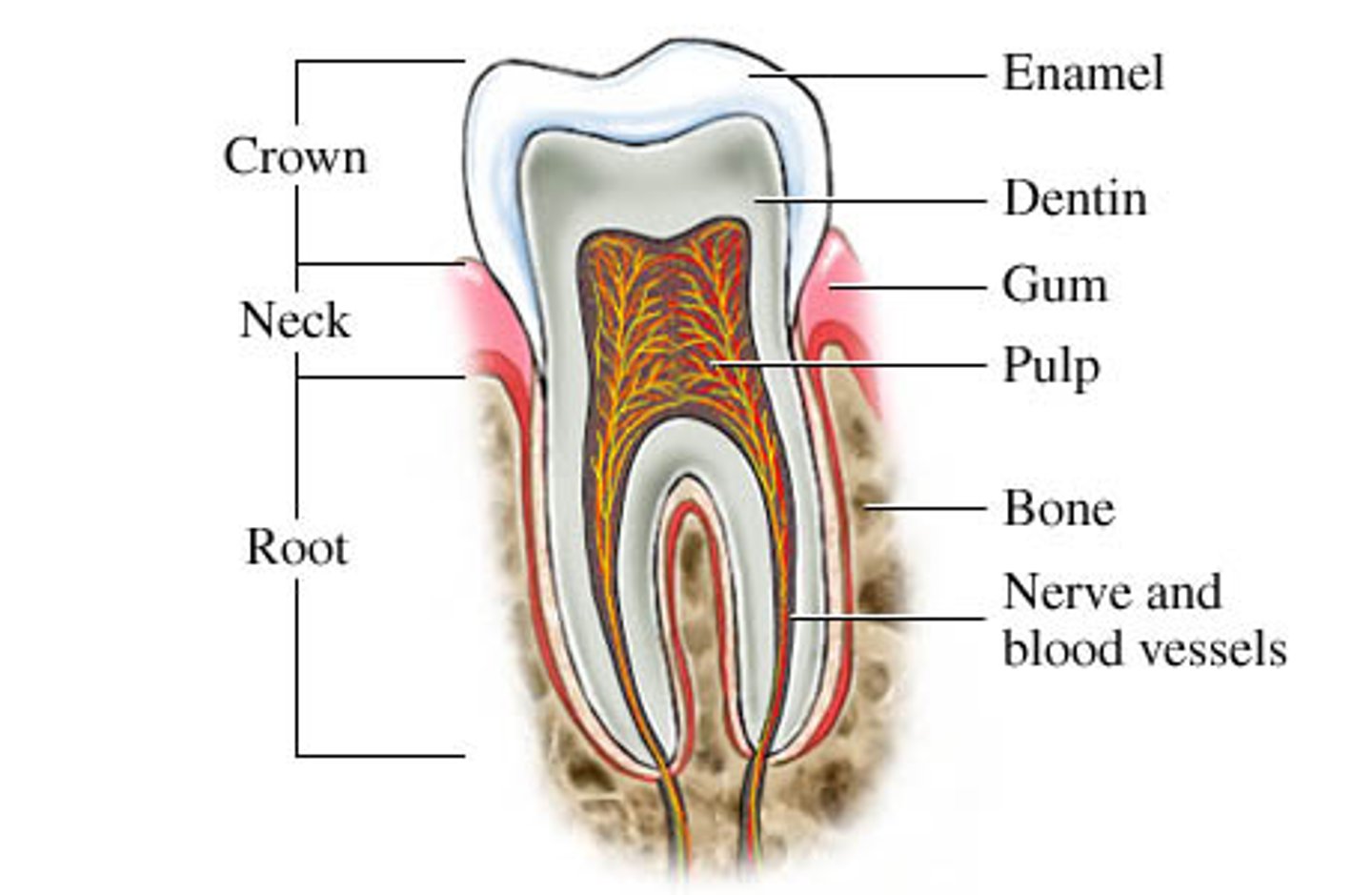
undivided portion of root is called the...
root trunk
point of root division is called
bifurcation (if two roots) or trifurcation (if three roots)
root canal
where the pulp cavity extends into the root
apical foramen
the hole at the tip of the root where nerves and blood vessels enter the tooth - root canal to external environment
name the two soft tissues in the periodontium
gingiva
periodontal ligament
name the two hard tissues in the periodontium
cementum
alveolar bone
functions of teeth
1. mastication (eating)
2. appearance (support to facial expression)
3. speech (need tongue to touch certain teeth)
4. growth of jaws (mainly for deciduous)
name all surfaces of tooth
1. FACIAL (labial/buccal)
2. LINGUAL (lingual or palatal)
3. PROXIMAL (mesial or distal)
4. MASTICATORY (incisal edges or occlusal surfaces)
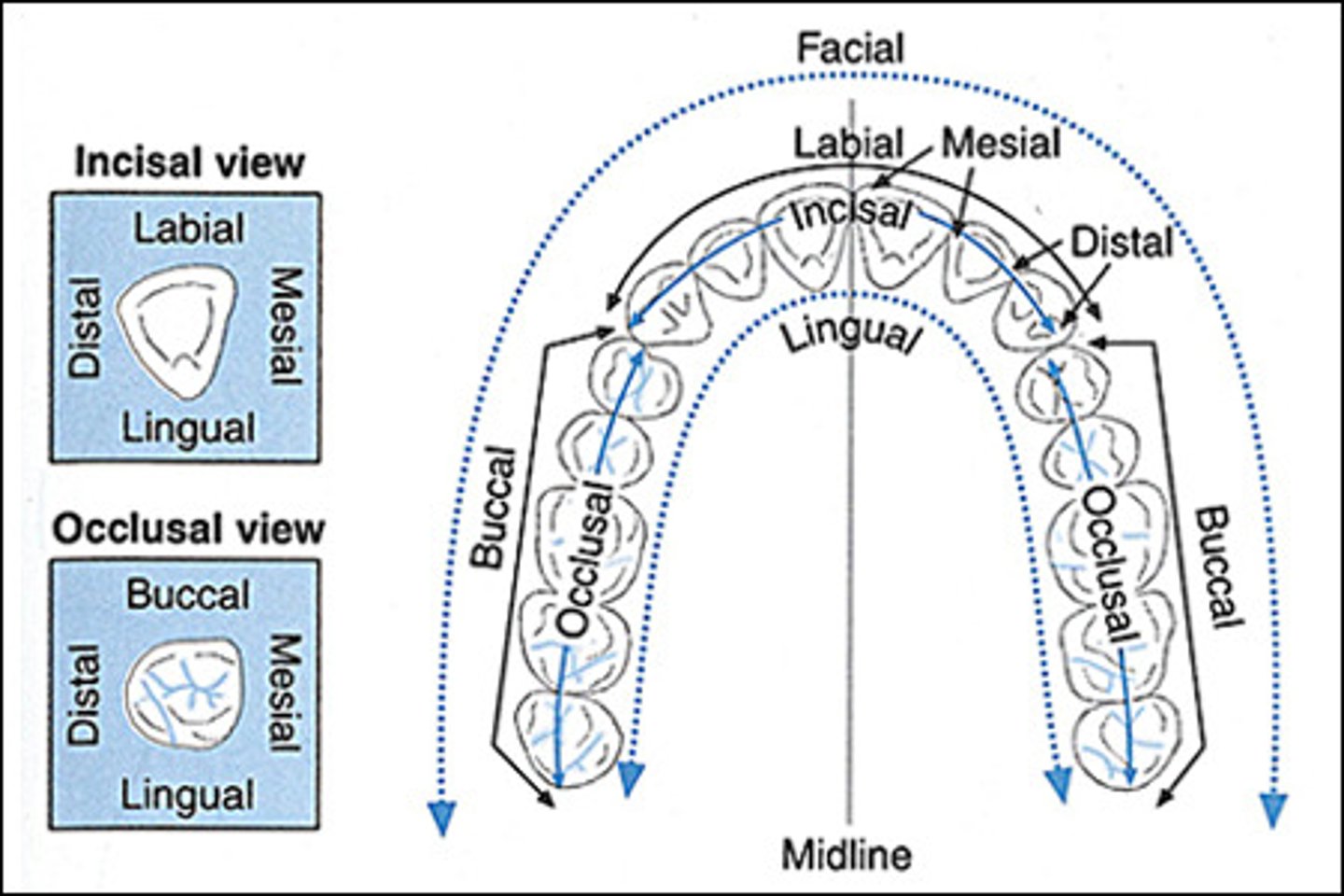
line angle
2 surfaces of tooth joined
eg) disto-buccal
point angle
Angle formed by the junction of three surfaces
ordering for naming point/line angles
mesial/distal first
then labial/lingual
then incisal/occlusal
how many possible angles for anterior teeth?
6 line
4 point
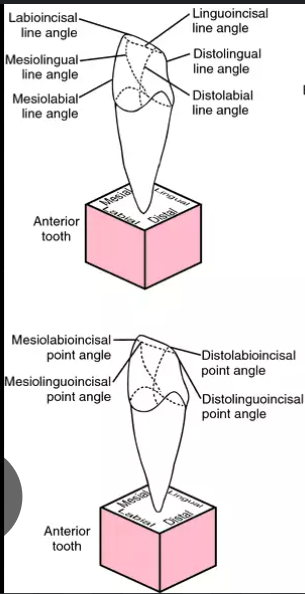
how many possible angles for posterior teeth?
8 line
4 point

name all thirds portions of tooth HORIZONTAL
C incisal 1/3
C middle 1/3
C cervical 1/3
R cervical 1/3
R middle 1/3
R apical 1/3
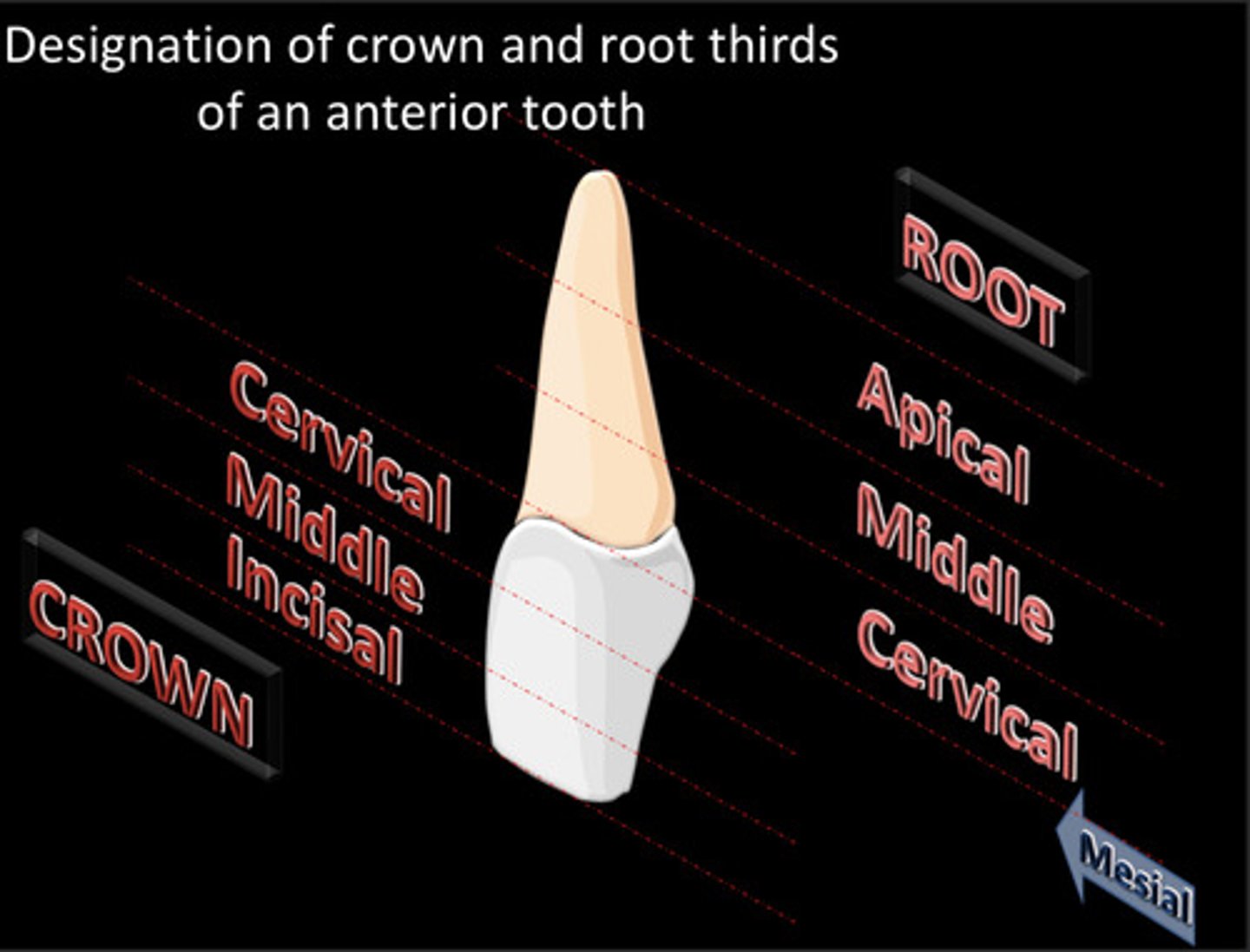
name all thirds portions of tooth VERTICAL LABIAL
C distal 1/3
C middle 1/3
C mesial 1/3
R distal
R mesial
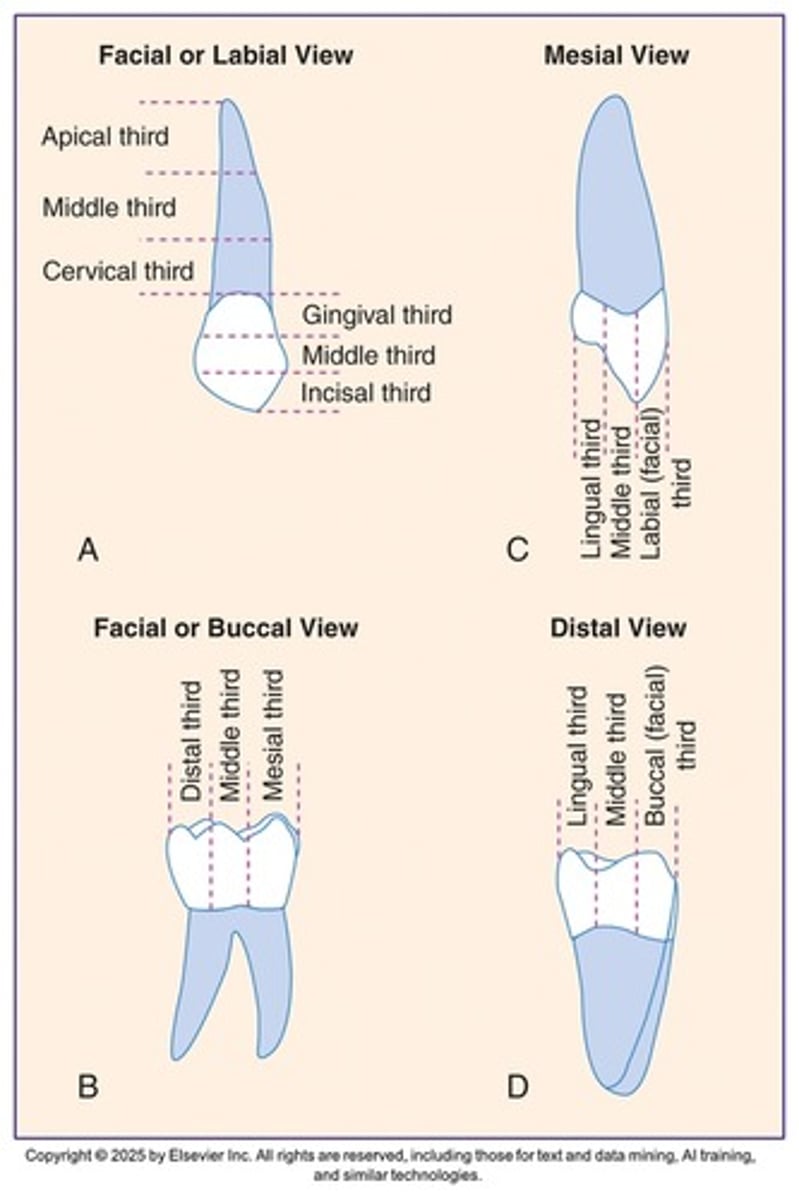
name all thirds portions of tooth VERTICAL MESIAL ANTERIOR TOOTH
C labial
C middle
C lingual
R labial
R lingual
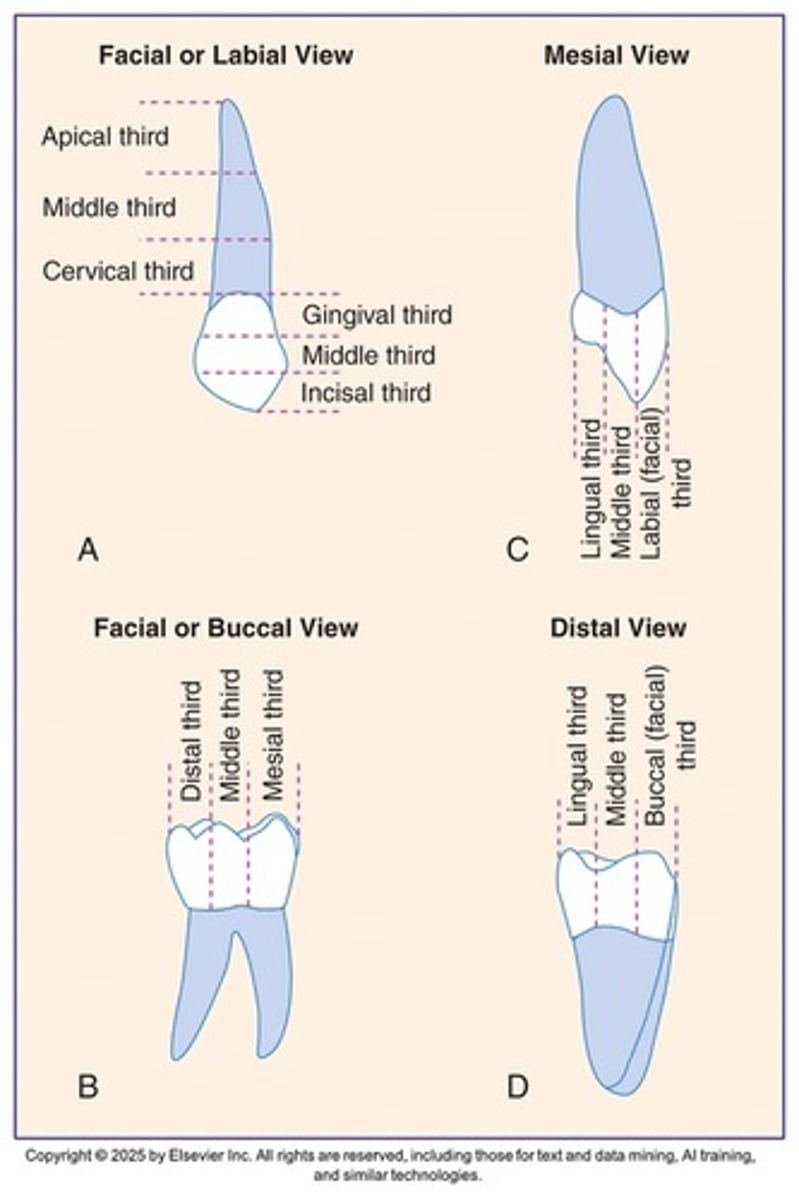
palmers identification system
find!
upper right first premolar P
lower left second molar D
lower right central incisor D
upper left canine P
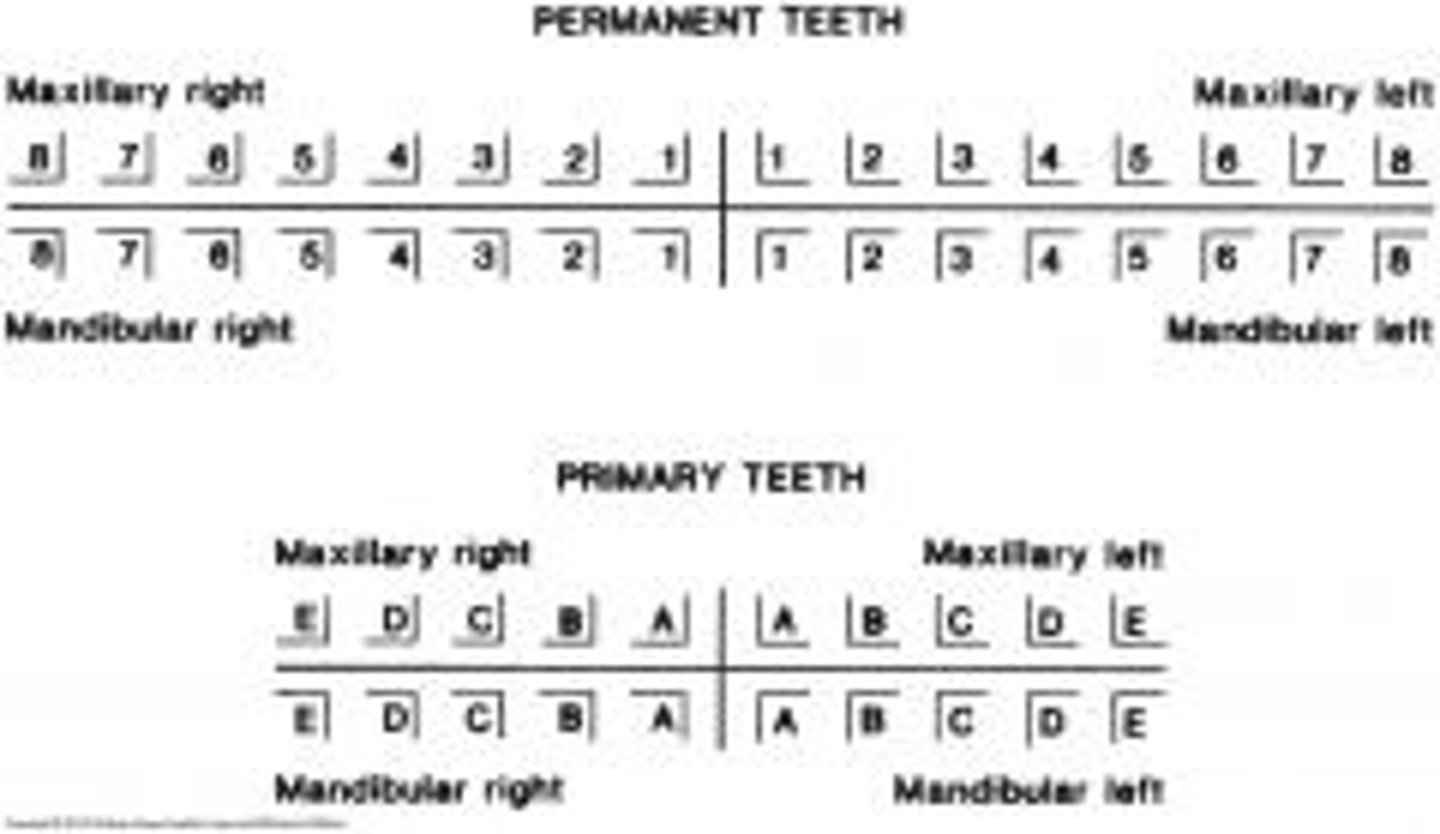
international 2-digit tooth identification system
find!
lower left canine D
upper left second premolar P
lower right lateral incisor D
upper right third molar P
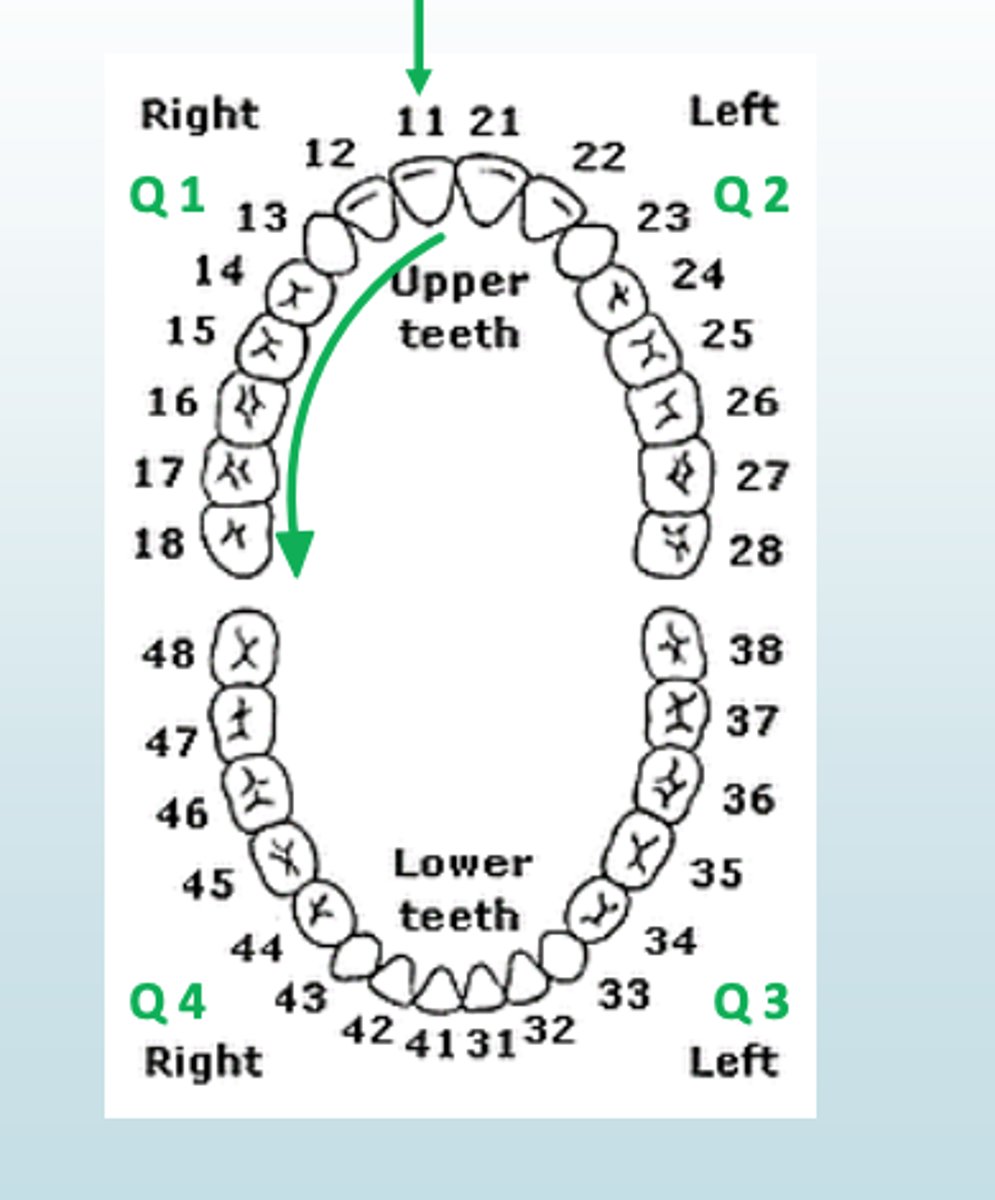
universal numbering system (american)
find!
upper right central incisor D
upper left second molar P
lower left third molar P
lower right first molar D
REMEMBER THE HASHTAGGGG
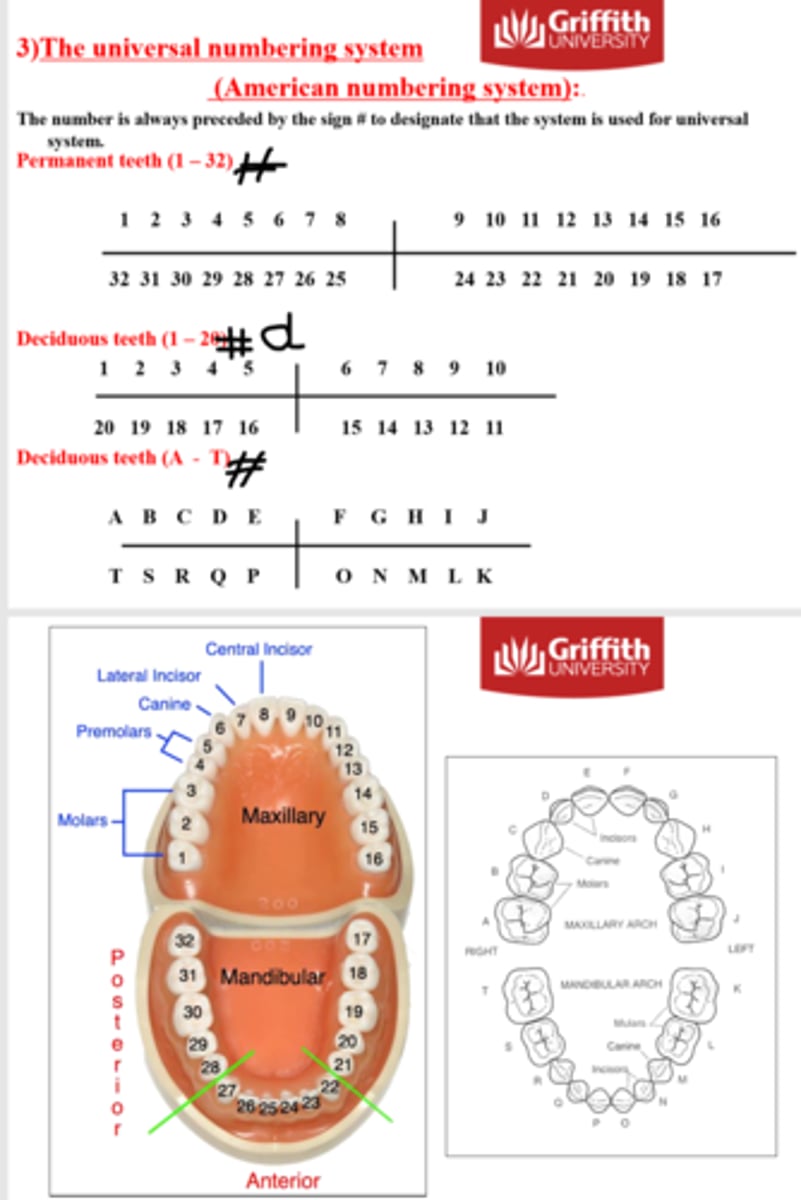
name all types of anterior teeth
central incisor, lateral incisor, canine
list characteristics of upper permanent central incisor
- trapezoidal shape
- linear elevation at cervical upper 1/3rd of tooth crown (cervical ridge)
- 4 lobes (3 mamelons and 1 cingulum)
- has fossa
boundaries of fossa
- 2 on margins (mesial marginal and distal marginal)
- 1 on incisal ridge
difference between incisal edge and incisal ridge
- edge contacts opposing teeth
- ridge little bit below edge (kinda on inside)
mesial side of upper permanent central incisor characteristics
- triangular in shape (thicker cervically)
- convex at cervical ridge, then straight, then curved convexity indicating incisal ridge
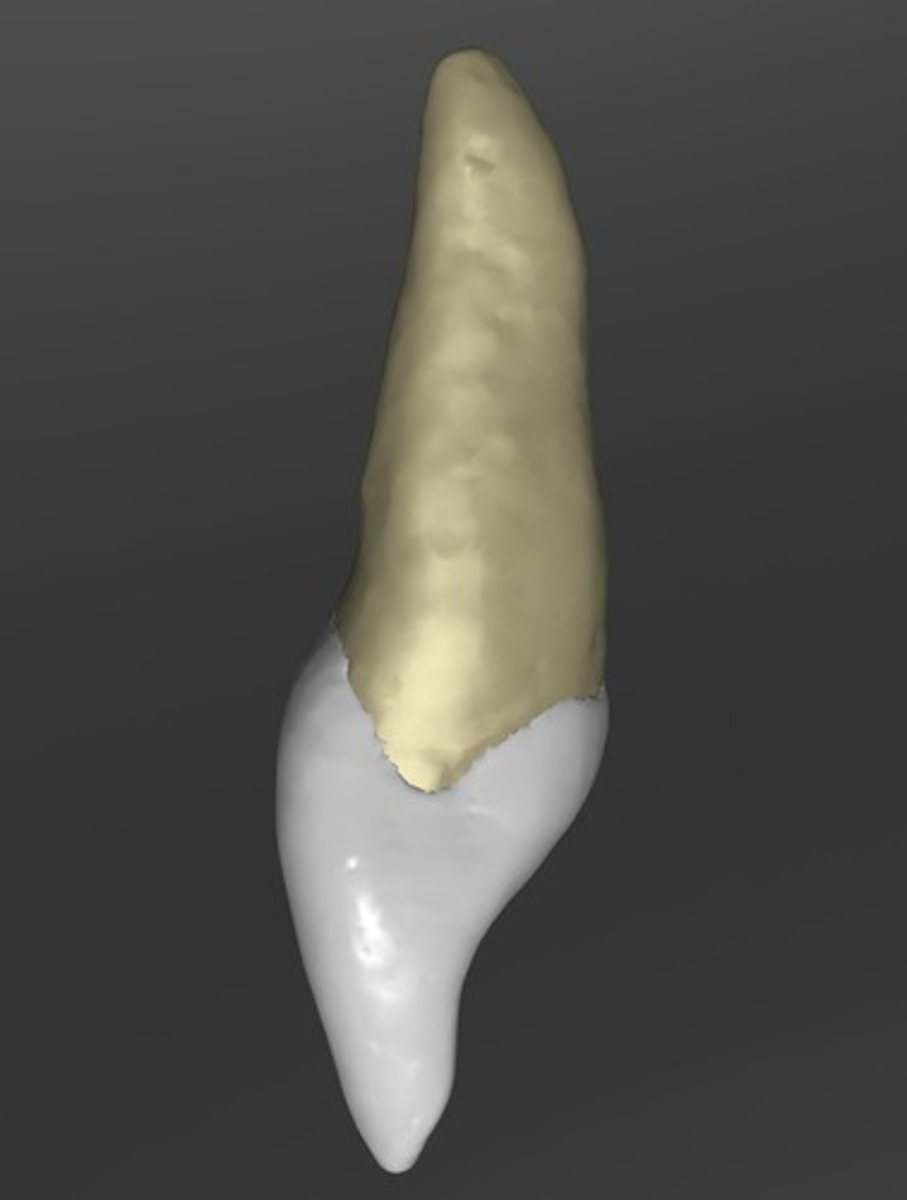
differences between mesial and distal surfaces of any tooth, list them (CCS)
1. contact area (more cervical on distal compared to mesial)
2. curves of cervical line (less on distal compared to mesial)
3. size (distal smaller than mesial - distal convergence)
what is lingual convergence?
Tooth is wider on facial aspect than lingual aspect
- important for tooth alignment in oral cavity (u-shape)
- 1 mil total difference (0.5 mesially, 0.5 distally)
differences between upper permanent central and lateral incisor
- pretty much same but laterally (distally) shifted
- incisal edge slopes distally
- cingulum twisted distally
- root apex curved distally
ONLY TOOTH WITH PALATAL PIT (pinpoint depression)
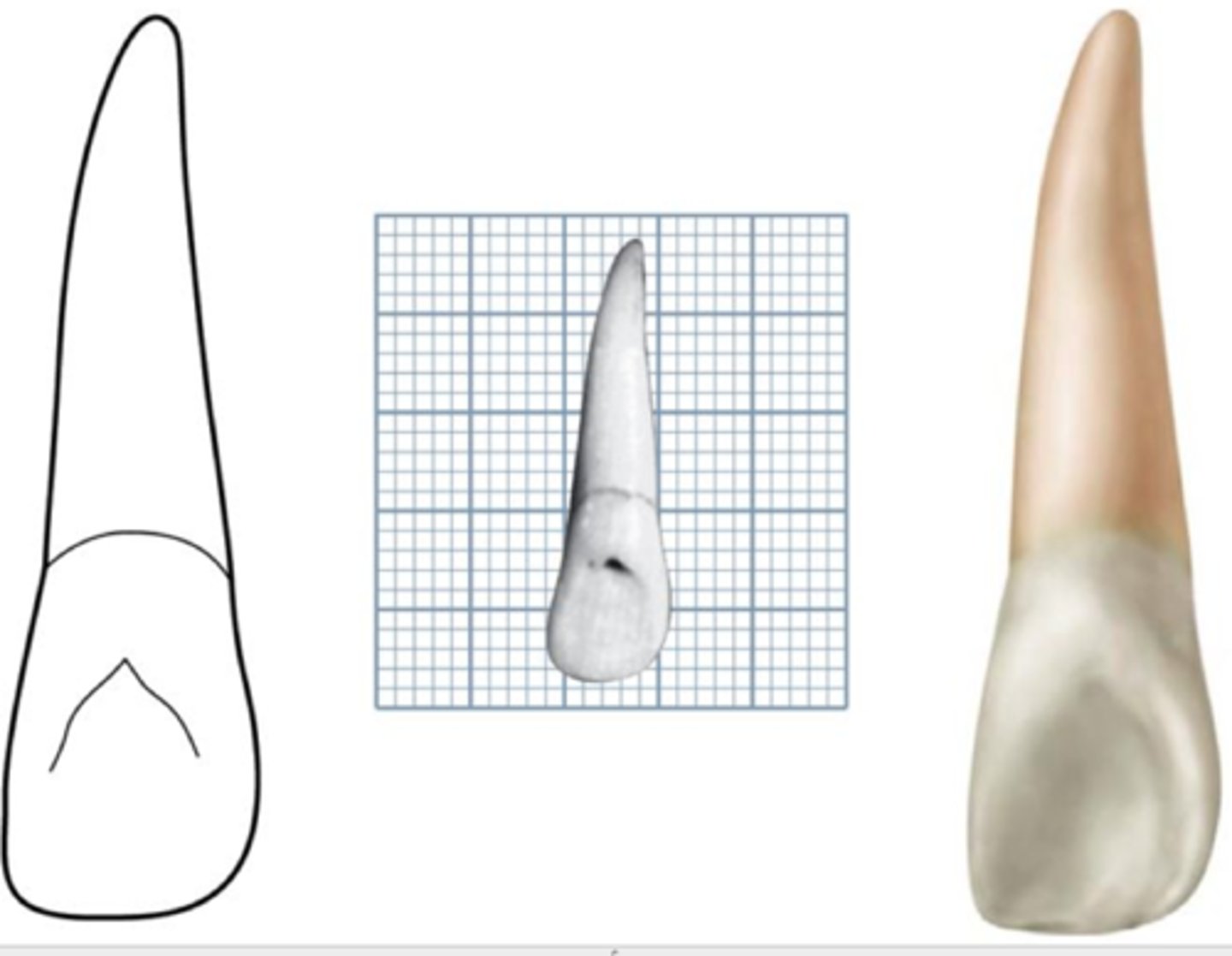
3 steps for identifying any tooth
1. hold tooth in correct anatomical position
2. have labial surface facing you (or person identifying)
3. find mesial surface first through any anatomical landmark
upper permanent canine characteristics
- labially trapezoidal shape
- no incisal edge, have cusp instead (pyramidal projection)
- middle labial lobe creates linear elevation on labial surface bc its overdeveloped (labial ridge!)
- upper canine has longest root in all oral cavity teeth
- lingual ridge (similar to labial ridge)
- from cusp to cingulum, lingual ridge divides 1 fossa into two IN UPPER ONLY. BOTTOM ONLY HAS 1 LINGUAL FOSSA
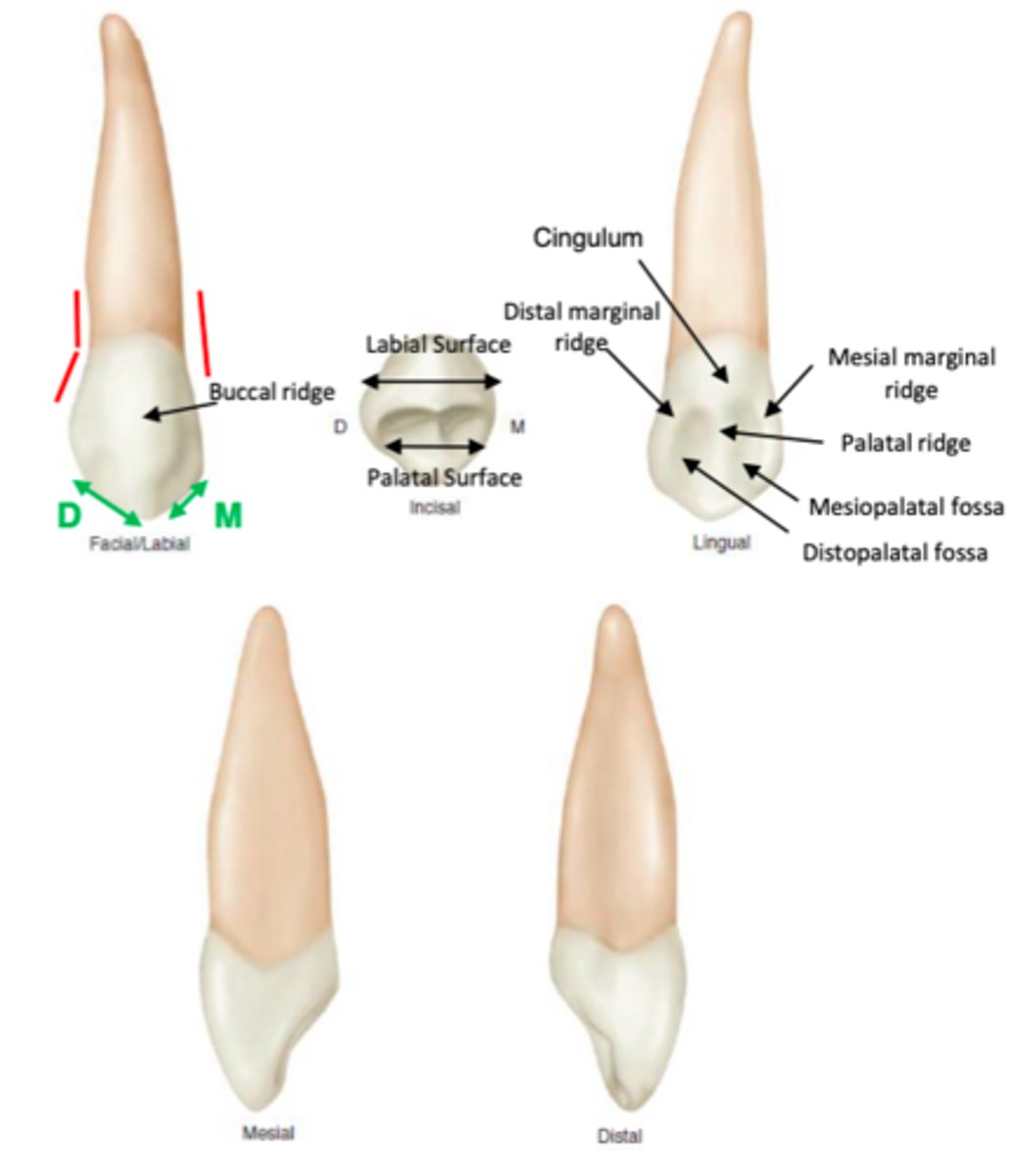
differentiate between upper and lower canines (supermodel)
- none of the canines can be supermodel!
- upper canine legs are really long but its super thick crown (NO MODELLING FOR YOU)
- lower canine is long body, but thick legs (NO MODELLING FOR YOU EITHER)
two categories of anatomical landmarks
elevations and depressions
3 crown elevations
- lobes (mamelons, cingulum, cusp)
- tubercle
- ridges
lobes characteristics
- primary centres of calcification and growth formed during crown development
- every tooth should have 4/more lobes (any less is underdeveloped)
- mature form represented by mamelons, cingula or cusps
when can you have 3 lobes and still have a fully developed tooth?
in premolars and molars - any buccal cusp is considered 3 lobes
cingulum characteristics
where present
why important
what happens if too big
what happens if too small
- cervical 1/3rd at lingual surface at crown of anterior teeth (also called lingo-cervical ridge)
- important bc slows down food before hitting gums
- if too big, food deflected away from gums, reducing blood circulation and stimulation
- if too small, gums will recede bc food wears down at them from trauma
cusps characteristics
- pyramidal projections (on incisal portion of canines, and occlusal surfaces of posterior teeth)
- usually named after closest tooth surfaces/line angles
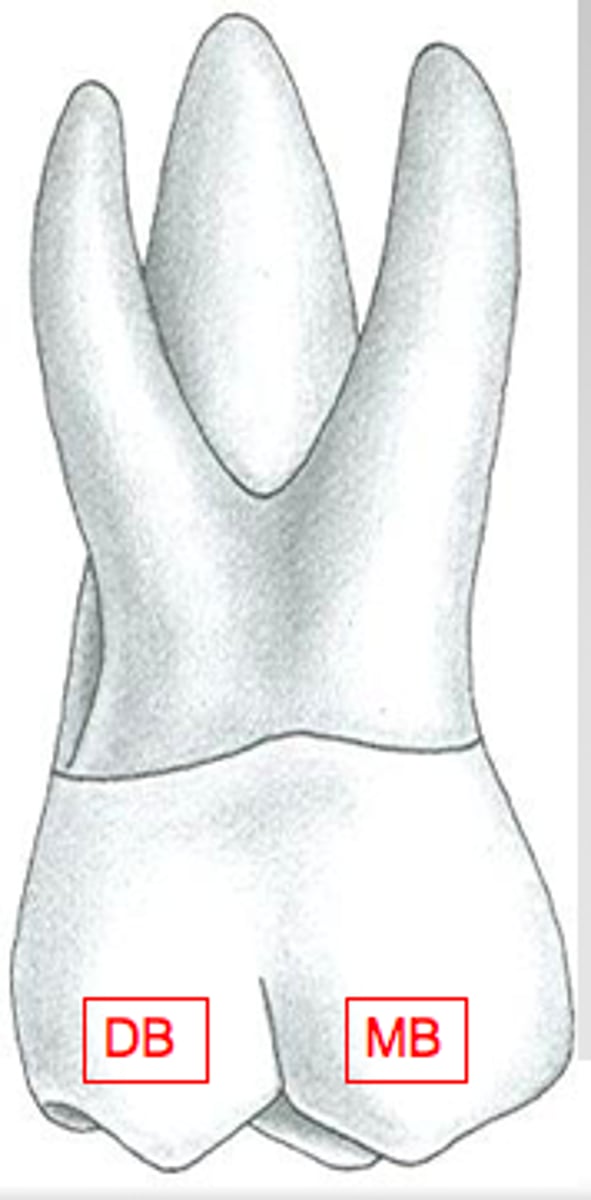
in premolars, buccal cusps always considered as 3 ______/______
pieces/lobes
tubercle characteristics (where sometimes found? i forget to include this)
- excessive enamel production causes these
- common on e & 6
- only made of enamel
- sometimes on lingual surface of incisors over cingulum
name different types of ridges
1. labial/buccal ridge - labial on canines, buccal on premolars. represents overdevelopment of middle labial/buccal lobe
2. marginal ridge - on mesial/distal margins on all lingual surfaces of anterior teeth and occlusal surfaces of posterior of mesial/distal boundaries
3. lingual ridge - only in canines!
triangle ridges, transverse ridges and oblique ridges
- on posterior teeth
TR
- all posterior cusps have these (exc. mesiolingual cusp on maxillary molars)
TR
- on occlusal surfaces on lower premolars
- represents union btwn triangular ridges of 2 opposing cusps
OR
- on occlusal surfaces of upper molars
- union between 2 non-opposing cusps
- MESIOLINGUAL OR DISTOBUCCAL ONLY!
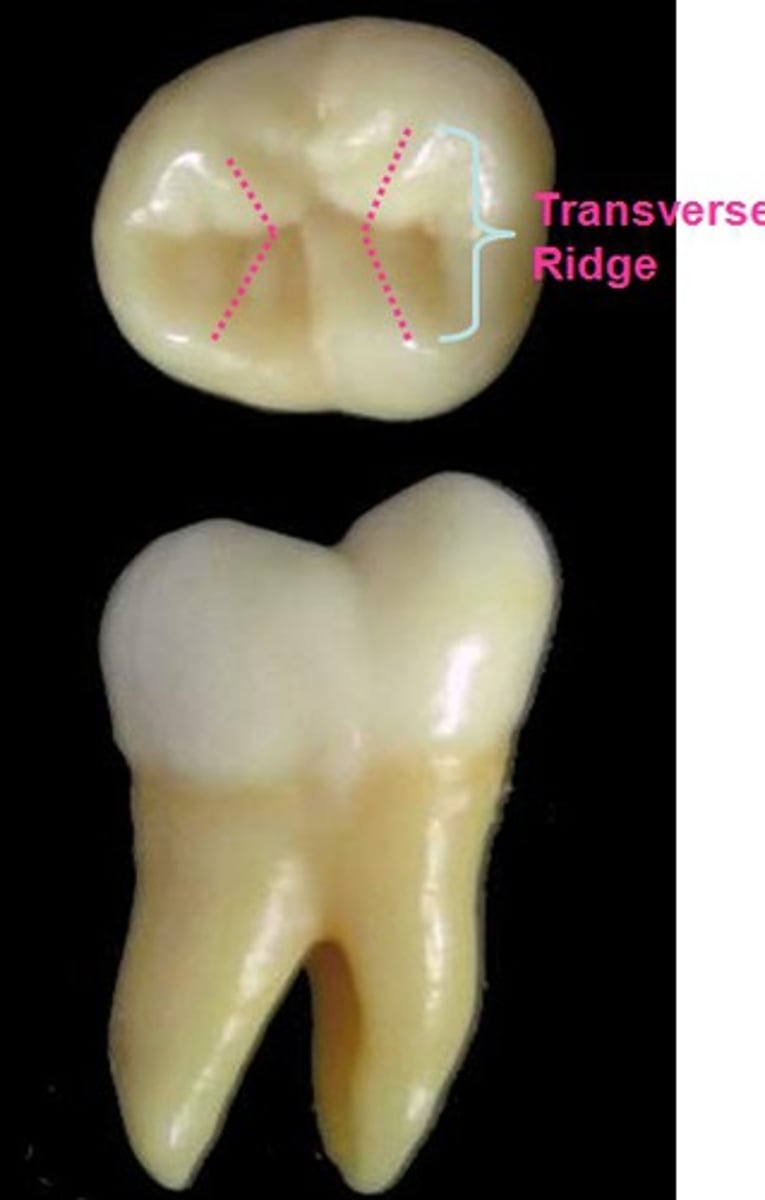
name all types of linear depressions
- developmental grooves (good news)
- supplementary grooves (neither good or bad news)
- fissures - (bad news)
what are developmental grooves
the junction that forms from the union of developmental lobes
- narrow, shallow and sharply defined
what are supplementary grooves
- small, irregularly placed grooves that branch from developmental grooves
- found on occlusal surfaces
- 2nd/3rd prem and 2nd mol characterised by high freq. of these
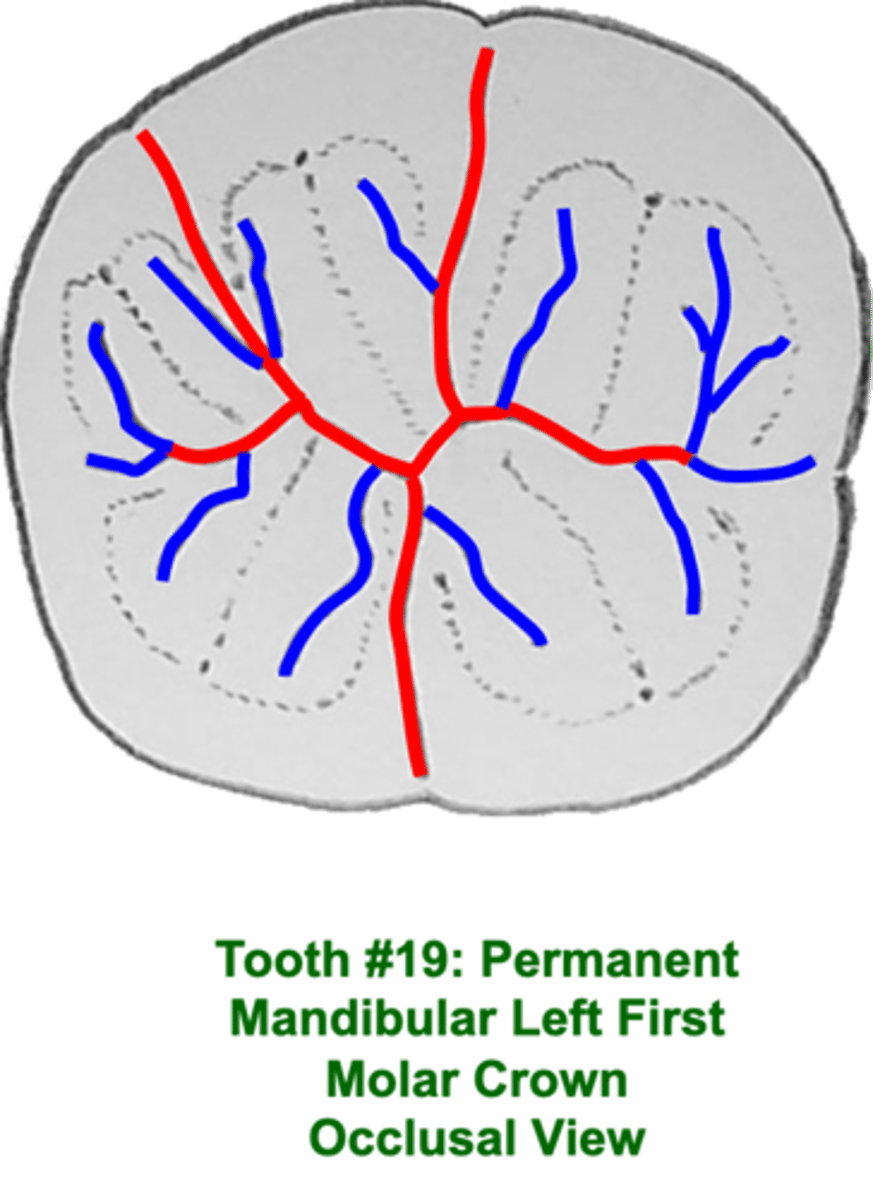
what are fissures
- found in bottom of dev. groove
- incomplete union of primary lobes
- fault in enamel
- invisible. but can feel when probing
- same as developmental, just deeper
- can be high risk of decay starting point, esp. if deep. shallow is okay
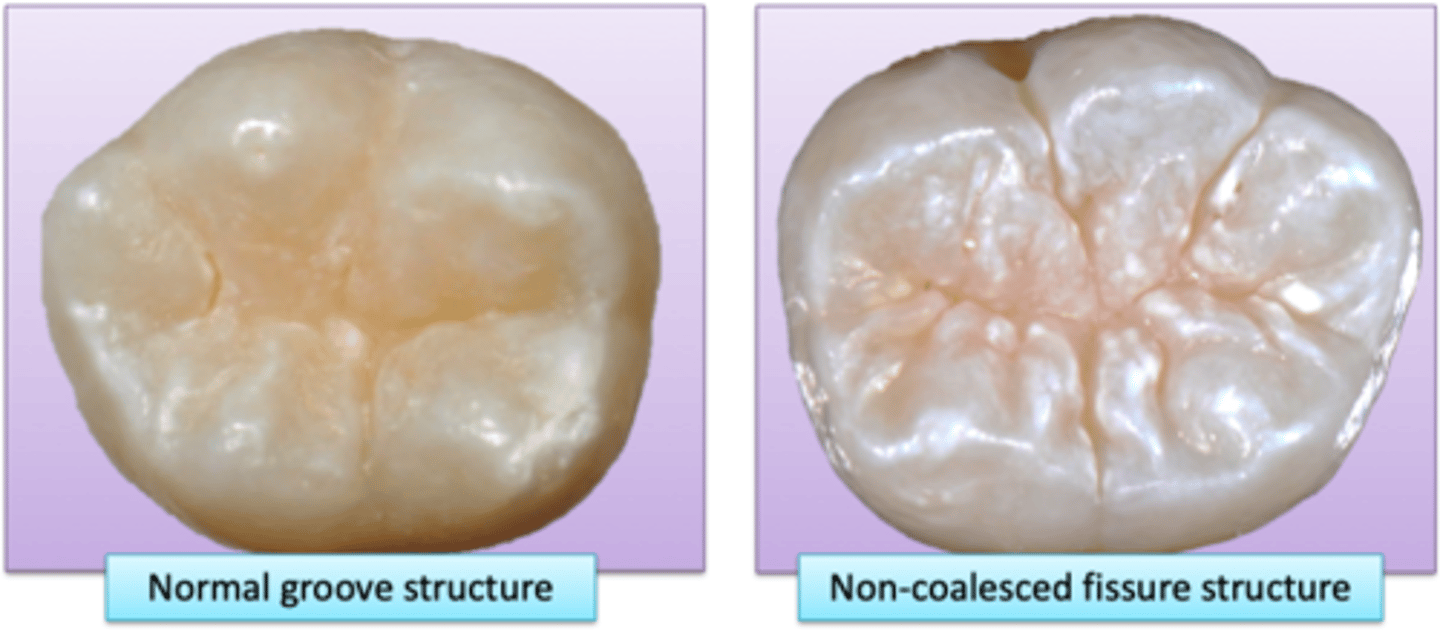
mesial and distal triangular fossae
- on occlusal surfaces on posterior teeth
- mesial bigger than distal in size
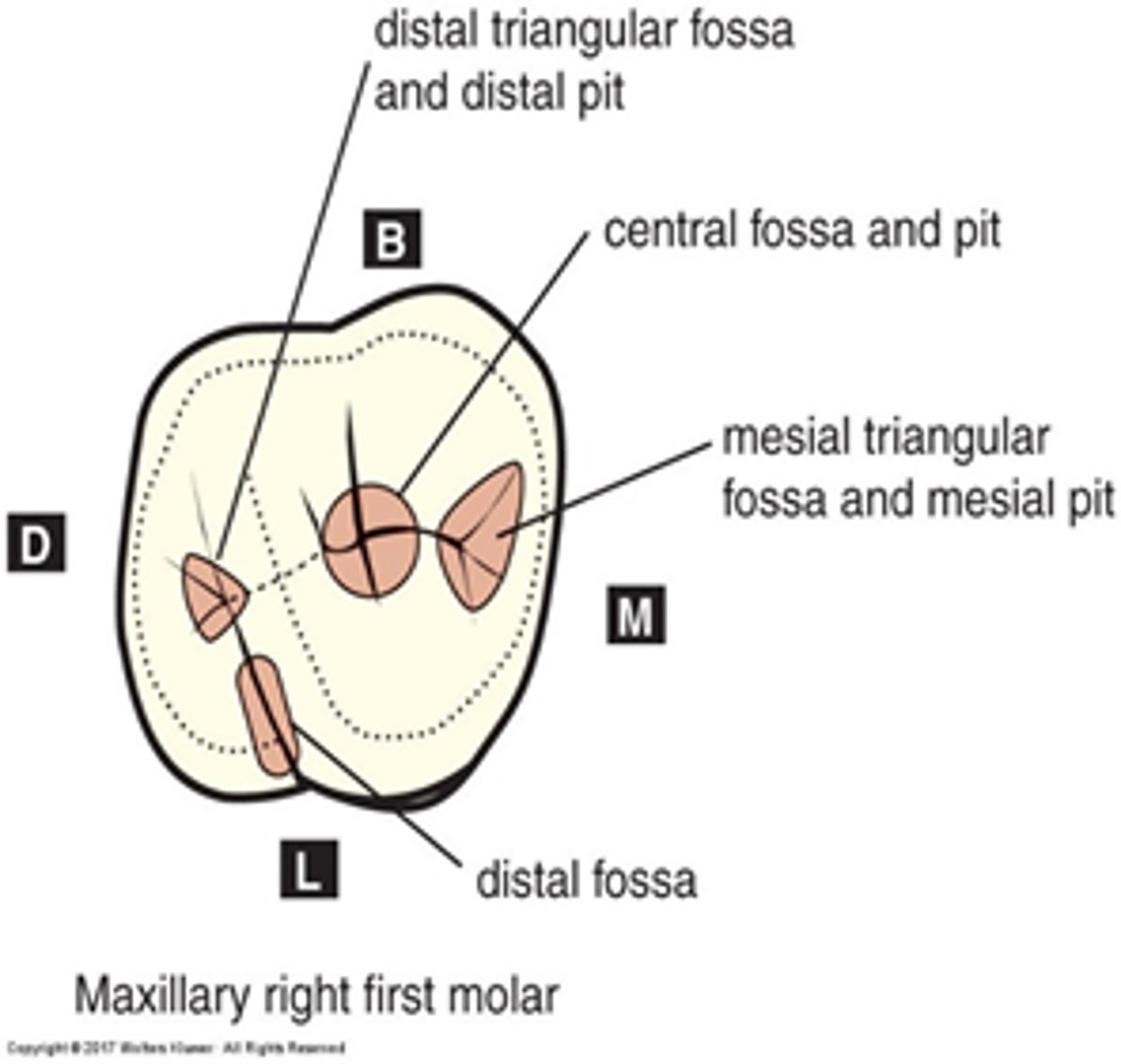
what are pits?
- pinpoint depressions at developmental groove junctions
- either true or false/faulty
true pit
- small pinpoint depression
- found at bottom of the central fossa (central pit)
OR
- at the bottom of the mesial and distal triangular fossae (mesial & distal pits)
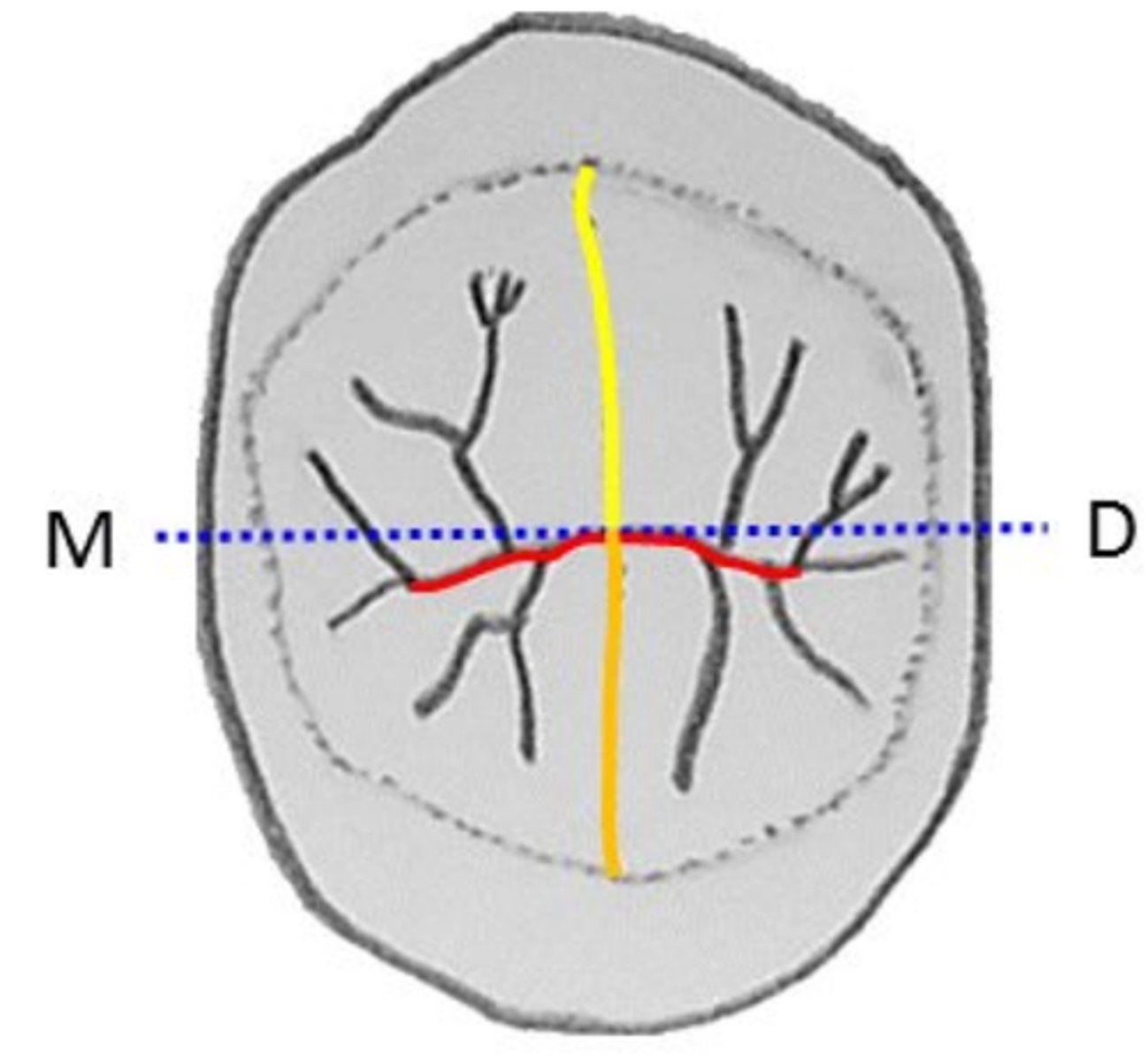
faulty pit
- usually develops as a result of incomplete formation of enamel
- located at the end of the buccal developmental grooves of the lower molars
OR
- palatal developmental grooves of the upper molars

sulcus (not pocket related lmao)
- triangular space between two cusps
- broad depression on occlusal surfaces on posterior teeth
- extend from dev. groove to cusp tips
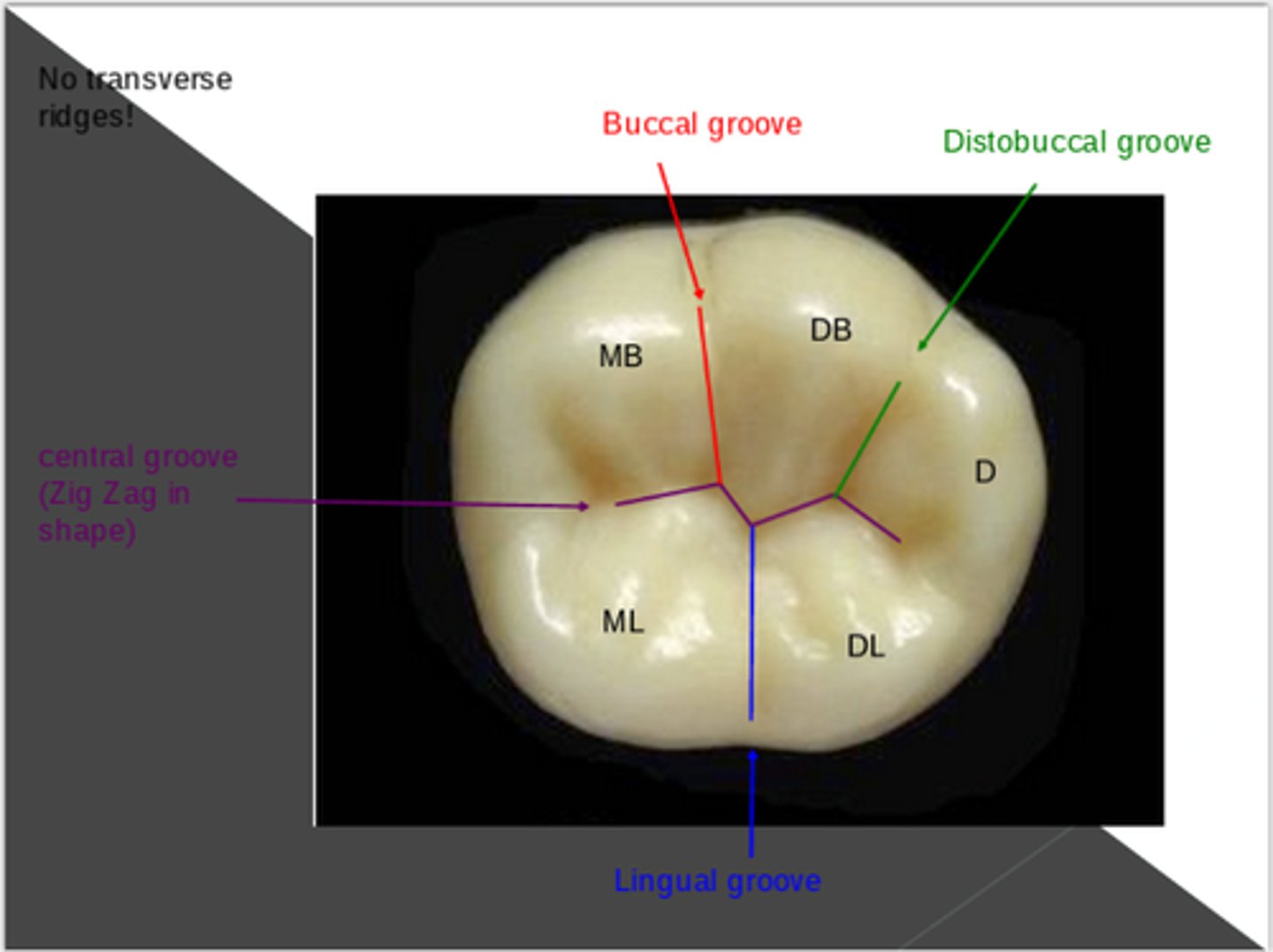
embrasure
- triangle space btwn 2 teeth
- spillway for food during mastication
- prevents food impaction
for any tooth, in the exam you will need to talk about 8 points. what are these eight points?
acronym: funky ducks never go crazy singing rnb, people
1. function (mastication, aesthetics, speech)
2. date of eruption
3. number of lobes
4. geometrical outline of the crown
5. crown outlines
6. surface anatomy of the crown (elevations/depressions)
7. roots
8. pulp cavity
5 aspects of any tooth
1. labial/buccal
2. lingual
3. mesial
4. distal
5. incisal/occlusal
maxillary permanent central incisor points 1-4 (labial)
1. incising food, speech and big in aesthetics from patient pov (middle of mouth, large tooth etc)
2. 7-8 years
3. 4 lobes (3 mamelons, 1 cingulum)
4. trapezoidal shape (short uneven side cervically)
maxillary permanent central incisor points 5-7 (labial)
5. formed of mesial, distal, cervical and incisal outlines (distal bulges more than mesial)
6. elevations: cervical ridge
smooth and convex with max convexity at cervical 1/3
mes-inc angle sharp, dist-inc angle rounded
depressions: shallow dev groove could be seen between mamelons
7. single root
1/5 rule
1 for upper perm central incisor
5 for lower 2nd premolar
only 2 where root is straight all the way with no developmental depressions
maxillary permanent central incisor lingual side point 6 (as 1-5 all same as labial)
1-5 all same:)
6. lingual convergence (smaller than labial side by 1mm)
elevations: cingulum, incisal ridge, marginal ridges (mesial + distal)
depressions: lingual fossa
mesial surface of maxillary permanent central incisor points
1-3 all same
4. triangular in shape with base cervically and tip incisally
5. cervical ridge, cingulum, incisal edge, cervical outline
6. contact area on incisal 1/3rd of crown
7. smooth with no developmental depressions
differences between any mesial and distal surface (some will apply to any, others will be specific to perm. central incisor fyi!)
1. disto-lingual convergence (distal side narrower)
2. contact area more cervical on distal
3. cervical line less curved distally
4. developmental depressions deeper on distal surfaces of roots (if present)
pulp cavity (point 8) of maxillary permanent central incisors (pulp chamber and root canal)
- pulp chamber: outline follows crown and in young teeth has horns following mamelon outline)
- root canal: ends in apical foramen, incisors have only 1, only follows root outline
maxillary permanent lateral incisors 7 points compared to central
NOTE: won't be following order, just label 7 differences!
1. smaller than central
2. distally sloping incisal edge
3. distally twisted cingulum
4. distally curved root
5. palatal pit (UNIQUE FEATURE)
6. rounded mesio and disto incisal angles
7. more pronounced elevations + depressions (fossa is deeper, cingulum is higher)
mandibular permanent central incisor 6 points (not actual ones, just comparison to max. perm central)
1. smallest tooth in oral cavity
2. fan shaped (could also be trapezoidal) - called this because mesio and disto incisal edges are sharp
3. symmetrical (mostly)
4. incisal edge straight
5. mesio/disto-incisal edges sharp
6. cingulum centralised
mandibular permanent lateral incisor 5 points compared to lower central
1. larger
2. distally sloping incisal edge
3. distally twisted cingulum
4. sharp mesio-incisal, rounded disto-incisal angle
5. more pronounced elevations and depressions (if there)
lingual inclination. which teeth have these? why is it important?
crown is tilted lingually compared to long axis of roots
all lower teeth have this
important to acheive class 1 (normal) occlusion of oral cavity (upper teeth overlapping lower)
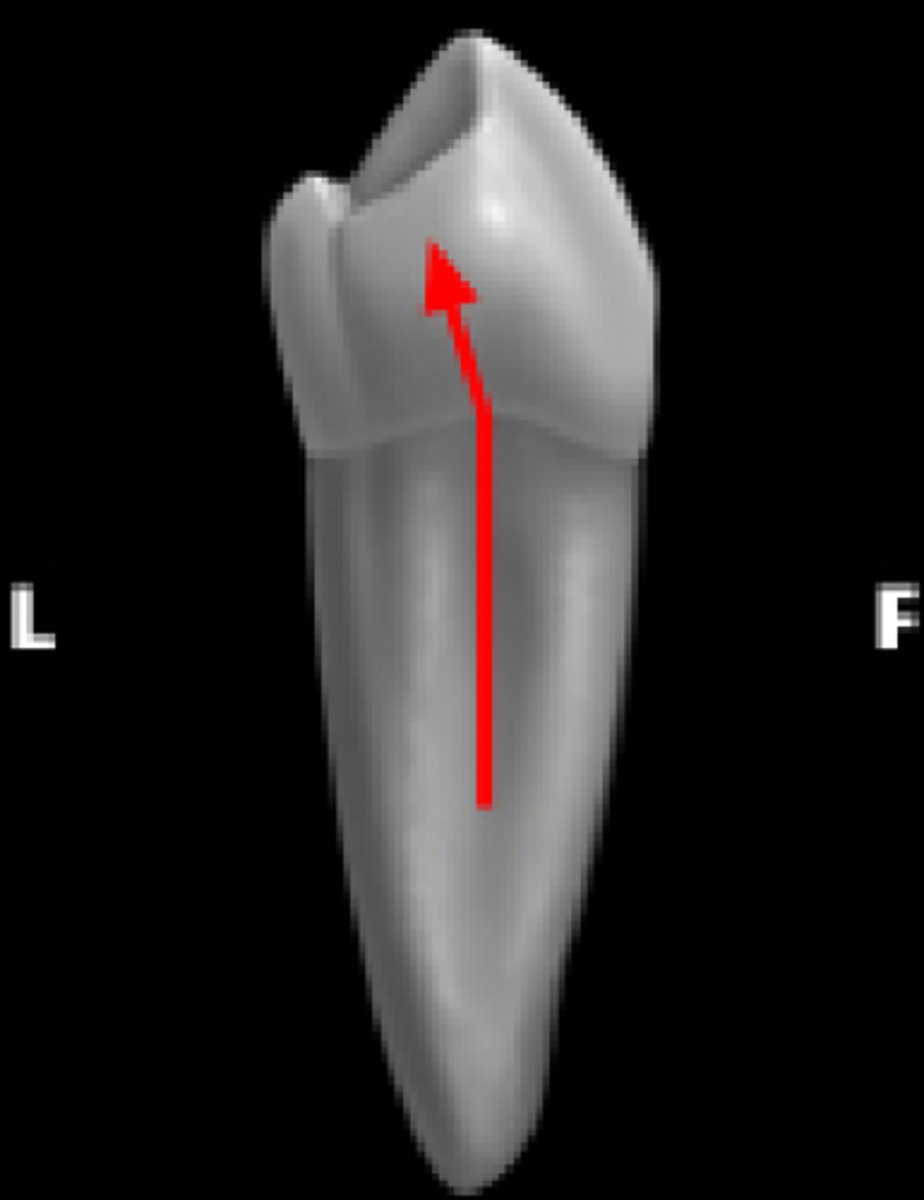
roots in lower incisors compared to upper incisors
upper: rounded tip, tapered from cervical to apex
lower: sharp tip, nearly straight from cervical to middle, then tapered (helps with stabilisation of roots bc crown smaller)

incisal surface of lower incisors
- incisal ridge of lateral incisors is more distally angled to allow dental arch curvature
(gets in contact with canines where this starts)
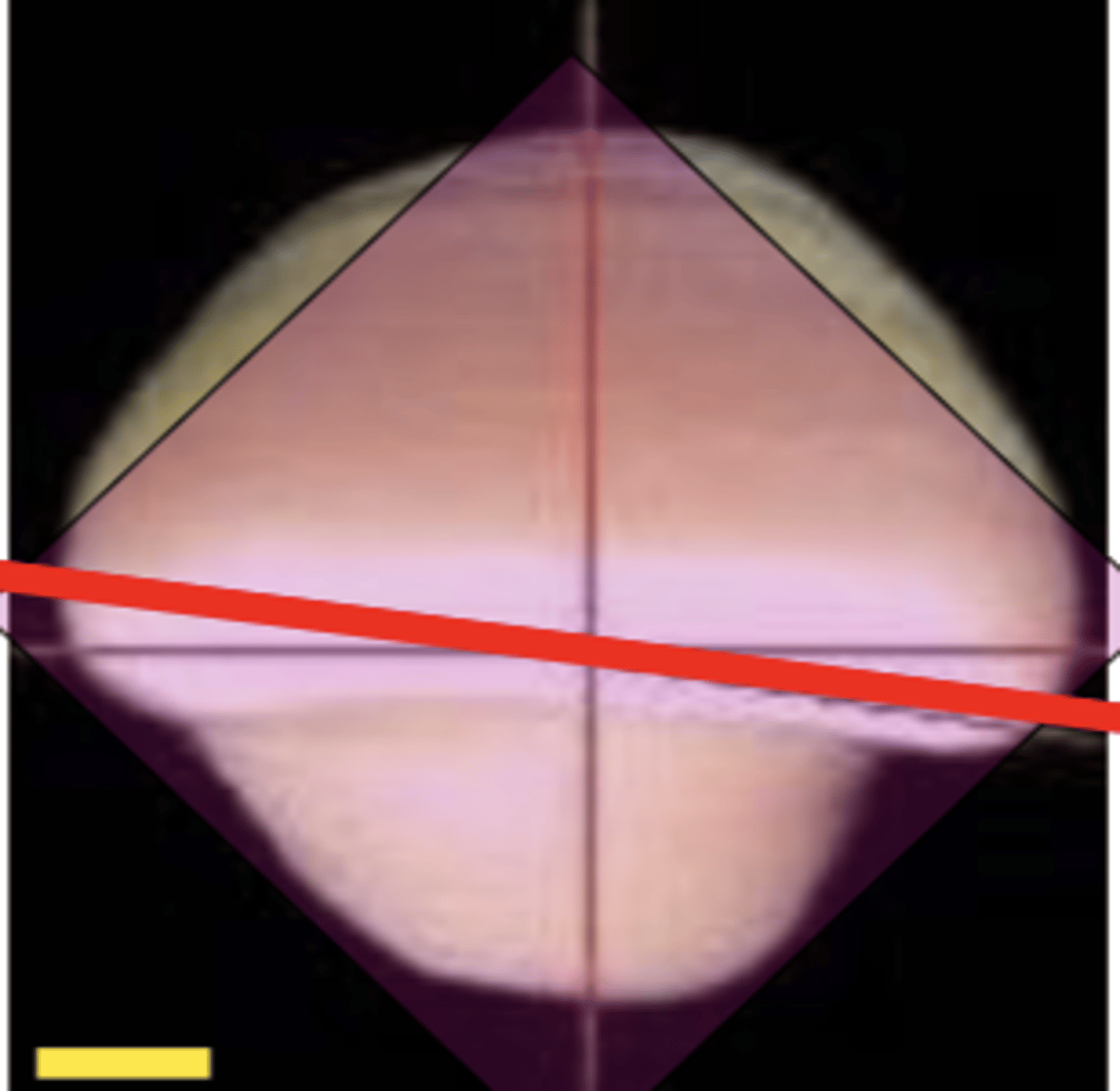
upper canines labial surface points 1-5
1. function: incising food, speech, appearance aesthetics
2. 11-12 years
3. 4 lobes (3 mamelons, 1 cingulum)
4. meant to develop like incisor, but middle lobe overdeveloped forming cusp tip on labial surface. same geometric outline (trapezoid with short side cervically)
5. mesial: convex til contact area (middle third) then concave cusp slope, distal: concave til contact area (middle third), then convex cusp slope. cusp tip slightly mesially deviated even though aligned with long axis
special thing about canine cusp slopes
cusp slope
outline
contact areas
embrasures
- distal cusp slope longer than mesial
- mesial outline longer than distal
- contact areas follow posterior teeth rules (mesial at incis. and middle 1/3, distal at middle 1/3)
- wider embrasures to have contact areas in centre of gravity of that tooth
upper canine labial surface point 6-7
- elevations: labial ridge, cervical ridge, middle lobe well developed (cusp)
- depressions: slight shallow longitudinal depressions lie mesial + distal to labial ridge
- single and longest root in oral cavity, curved distally
upper canine lingual surface point 6
- elevations: marginal ridges, cingulum, PROMINENT lingual ridge from cusp tip to cingulum
- depressions: lingual fossae divided into 2 by lingual ridge
upper canine mesial surface points 4-7
4. △ shape with base cervically + apex incisally
5. convex: cervical outline, labial outline, cingulum, incisal ridge, STRAIGHT: labial ridge
6. contact area at incisal and middle third of crown
7. shallow developmental depressions
upper canine distal outline points
- reverse outline of mesial
- distal convergence
- contact area more cervical
- cervical line less curved
- developmental depressions more pronounced on distal surfaces of root
upper canine incisal outline points
- diamond in shape
- thickness > width
- labial surface appears convex (more than incisors)
- cingulum forms short arc
- elev. and dep. in both labial + lingual surfaces appeared in this aspect
- cusp tips shifted 1mm labially (allow occlusion), 1mm mesially (bc distal cusp slope longer than mesial)
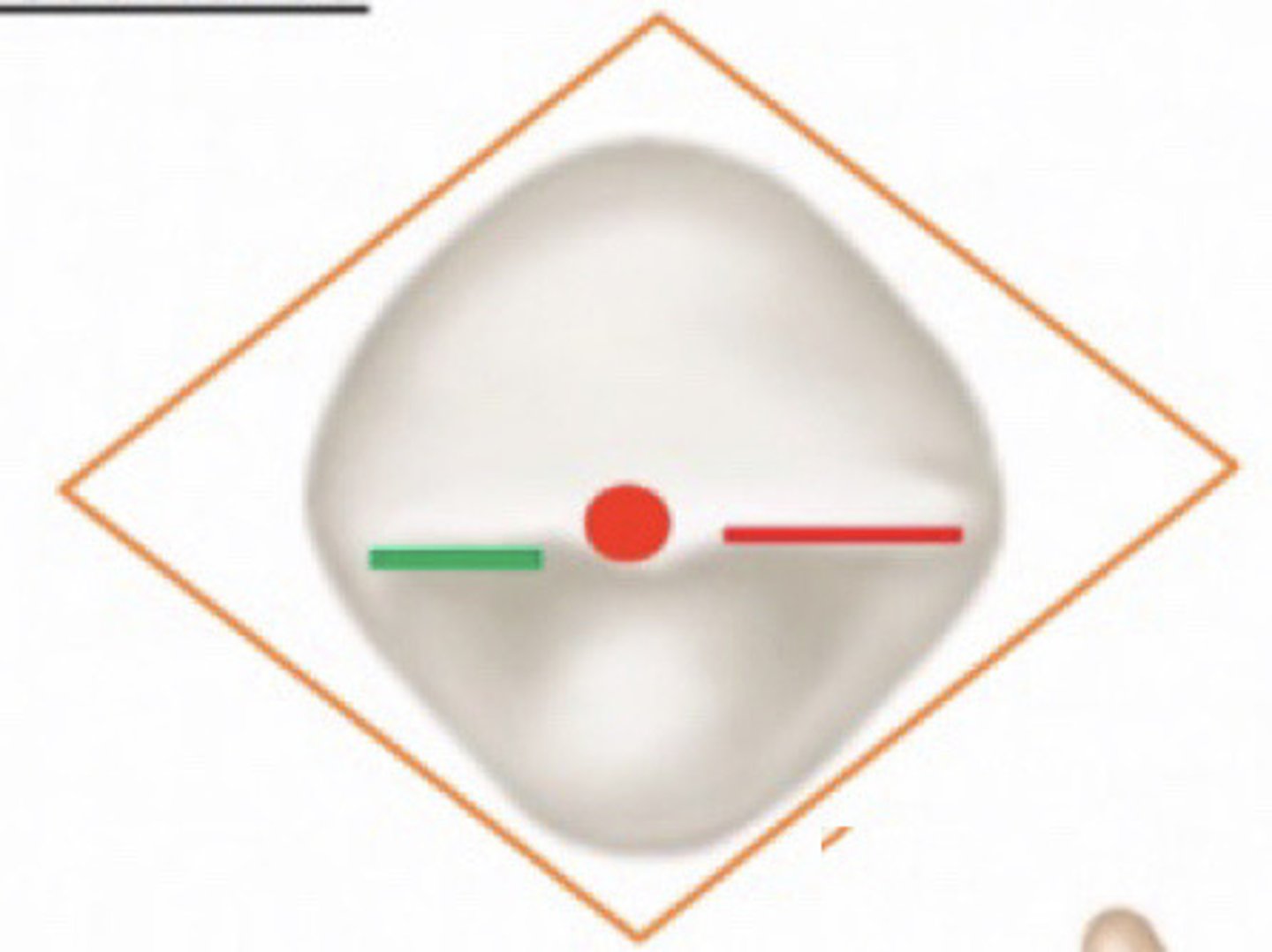
differences between upper and lower canines
- mesial outline curved in upper, straight in lower
- cusp tip more pointed in upper, rounded in lower
- elev. and dep. more pronounced in upper
- root outline tapered from cervical line to blunt apex (upper), root outline nearly straight from cervical to middle, then tapered to pointed apex (lower)
- mandibular can have bifurcated root and erupts earlier
- lingual inclination in lowers
upper perm first premolar labial surface points 1-4
1. grinding food, speech, aesthetics
2. 10-12 years
3. 4 lobes (3 mamelons, 1 lingual)
4. trapezoid with short side cervically
upper perm first premolar point 5 (excluding contact area bc this one is special, but make sure to include when doing exam!) (clue: thomas)
- thomas notches: mesial and distal cusp slopes are slightly concave
- cervical line convex root wise
- mesial and distal outlines nearly concave
upper first premolar contact area point (point 5 usually). why is it unusual? REBEL TOOTH POINT
- normally, the mesial cusp slope is shorter than the distal. in this tooth, the mesial is actually longer than the distal (rebel tooth)
- because of this, the contact areas have to change to adapt to this.
- the mesial is more cervical than the distal (D at junction of occlusal and middle, M in the middle)
upper first premolar labial side points 6-7
6.
elevations: smooth, convex at cervical ridge, buccal ridge present (overdevelopment of buccal lobe)
depressions: shallow dev grooves could be seen separating 3 buccal lobes
7. root/root: 80-85% have 2 roots, 15-20% single
- curved distally
- lingual root smaller than labial by 1mm so cant see labially
- tapered to point apex
- convex and smooth
upper perm first premolar lingual surface points
- reverse outline of buccal surface with lingual convergence
- L cusp shorter than B cusp by 1mm but sharper
- distal slope of L cusp longer than M slope
- convex, with max. convexity at middle 1/3 (no name lol, just called lingual maximum convexity or LMC)
- good to have LMC to slow down food and minimise repetitive trauma
upper perm first premolar mesial surface points 4-5
4. geometric outline - trapezoid with short side occlusally
5. lingual maximum convexity (LMC) with lingual outline convex.
- 2 cusps, buccal and lingual (buccal longer)
- cervical line curves occlusally, decreased distally
- narrow occlusal side is thinner and sharper (help canine to shred food)
(forces are distributed evenly for each unit of surface area, cervically less to help with cyclic masticatory loads, also helps with self-cleansing ability)
upper perm first premolar mesial surface point 6 (long one!)
- B > L length 1 mm
- widest occlusal table (distance btwn 2 cusps)
- L cusp not under tip like the B cusp bc roots start curving together and wide occlusal table
- MMR at junction of occlusal and middle 1/3, but DMR more occlusal (normally the mesial is meant to be more occlusal!)
- contact area shifted buccally (in contact with canine, different tooth group so changed)
- UNIQUE FEATURE - MMDG - right next to contact area lingually
- canine fossa (mesial developmental depression) in crown, continues thru root (LARGEST LANDMARK IN ORAL CAVITY) - caused bc it needs to accommodate the canine root so a depression was made - REBEL TOOTH AND UNIQUE FEATURE (bc distal meant to have larger depressions, not mesial!)
if the upper permanent first premolar has 2 roots, then the root trunk is...
- root trunk is half root length
- smooth and convex save for canine fossa below bifurcation
distal surface of upper permanent first premolar points (should have 6)
1. distal convergence
2. contact area more occlusal
3. cervical line less curved
4. no canine fossa (just normal dev. depression which is shallower than the fossa)
5. no mmdg
6. root trunk longer bc bifurcation near apical 1/3 (sharper on D side to counteract mesial component of forces
occlusal surface of upper perm first premolars point 5
5) hexagonal in shape
- six sides (2 buccal, 1 mesial, 1 distal, 2 lingual)
- MB and DB sides equal
- M shorter than D (BUT DOESN'T MEAN MESIAL CONVERGENCE EXISTS)
- this only exists bc mesial cusp slope longer than distal so has to compensate - domino effect
- ML shorter than DL
- more thick than wide
- lingual convergence
occlusal surface of upper perm first premolars point 6
6)
ELEVATIONS
- triangular ridges of buccal and lingual cusps
- mesial and distal marginal ridges
DEPRESSIONS
- central developmental groove
- mmdg (like a bump in the side)
- mesial and distal triangular fossae (D slightly smaller than M)
upper perm first premolar root points (which more accessible, which has less what which means what, root follows what outlines?)
- although L root is narrower and shorter, its more accessible
- L root has less dentin and cementum so more root which means its v. weak
- root follows crown outlines
compare upper 4 to upper 5 occlusal surface (first premolar to second premolar)
- upper 5 has a narrower occlusal table (intercuspal distance)
- oval shape of upper 5 compared to hexagonal upper 4
- thicker upper 5 M + D marg ridges (narrow space for central dev groove)
- upper 5 tends to be smaller than upper 4
- lots of supp. grooves
- NO MMDG
- △ fossa same size in both
if a tooth is diamond shape occlusally, what does that mean? which types of teeth have this shape? what are the rest of the teeth shaped like?
- diamond means that the thickness is greater than the width.
- only lower 1 and 2, upper and lower 3, and lower 4 have this shape.
- rest of teeth have △ shape occlusal surface
occlusal surface of lower first premolar points (elev + dep, severe what? what shape)
- diamond in shape
- SEVERE LING. CONVERGENCE (3 mil, usually 1 mil)
- mesial outline slightly curved (in contact with canine mesially!)
- distal outline convex
- EVERYTHING SHIFTED LINGUALLY
elev
- has transverse ridge (connects △ ridges of B and L cusps)
- 2 cusps (B + L)
dep
- central dev groove v. shallow
- in m+d △ fossae, have true pits. SNAKE EYES:)
- MLDG - mesio lingual developmental groove
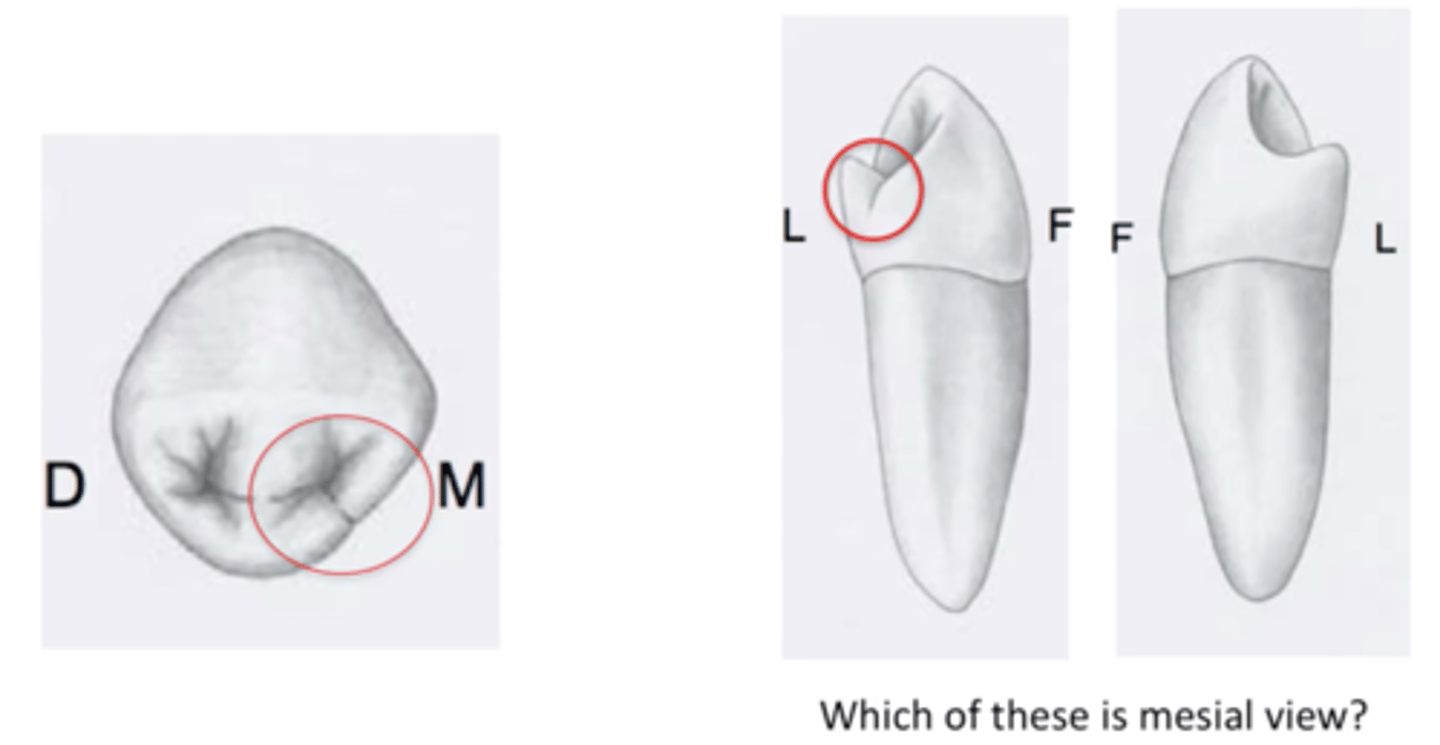
occlusal surface of lower second premolars point (generally!)
- may have 2 or 3 cusps (Y, U, or H shape) (2 buccal, 1 lingual)
bicuspid lower five points
- ovoid shape (intercuspal distance v. narrow)
- lingual convergence normal (1 mm)
- b + l △ ridge
- transverse ridge
- m + d ridges tend to be thicker than 1st premolars
- lotssss of supplementary grooves
- central dev groove could be H or U shape
- distal convergence
tricuspid lower five points
- square outline
- NO LINGUAL CONVERGENCE
- 1 buccal, 2 lingual cusps
- B > ML > DL in size
- LDG - lingual developmental groove inbetween 2 cusps
- no transverse ridge (has central fossa and pit instead)
- have MB, DB and L dev grooves
- supplementary grooves
- distal convergence